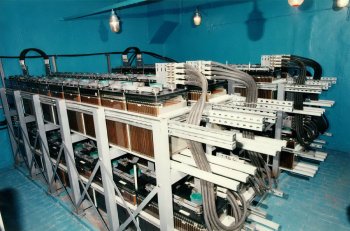![]()
Upgrading Safety Systems
Batteries Provide Reliable Backup Power for Emergency Shutdown
|
US Dept. of Energy Office of International Nuclear Safety and Cooperation 1000 Independence Ave S.W. Washington, DC 20585 (202) 586-6641 https://insp.pnnl.gov:2080/ |
When an earthquake or other emergency disrupts normal power supplies at a nuclear power plant, a backup power system must be available for controlling the plant and safely shutting down the reactor. At Russia's Kola and Kursk plants, backup power was provided by open-cell glass batteries. Cells in the batteries failed often, making the systems unreliable. Large amounts of hydrogen produced during recharging created a risk of explosion or fire that could damage the batteries, endanger plant workers, and threaten reactor safety. Furthermore, the fragile batteries could be damaged in an earthquake, making them unusable precisely when backup power was needed.
The United States has provided reliable backup power systems to replace those at Kola and Kursk. At these plants, workers have installed safety-grade batteries, mounted on seismically qualified racks. The sealed batteries have an expected operating life of 20 years. Their enclosed cell design releases minimal amounts of hydrogen gas during recharging. At Kola Units 1 and 2, workers installed two switchboards and two sets of batteries at each reactor and a fifth set of batteries shared by the two reactors. At Kursk Unit 2, the original backup system combined power loads for essential and non-essential safety equipment. Workers installed two sets of batteries to separate the safety from the non-safety loads, ensuring that the backup system can provide the power necessary to shut down the plant safely during an emergency. U.S. contractor Burns & Roe Enterprises, Inc., worked with Kola and Kursk personnel to determine emergency power loads and the battery sizes needed. In July 1997, U.S. and Russian specialists described their experience in the Kola and Kursk projects at a technology transfer workshop for representatives of Russian plants. |
